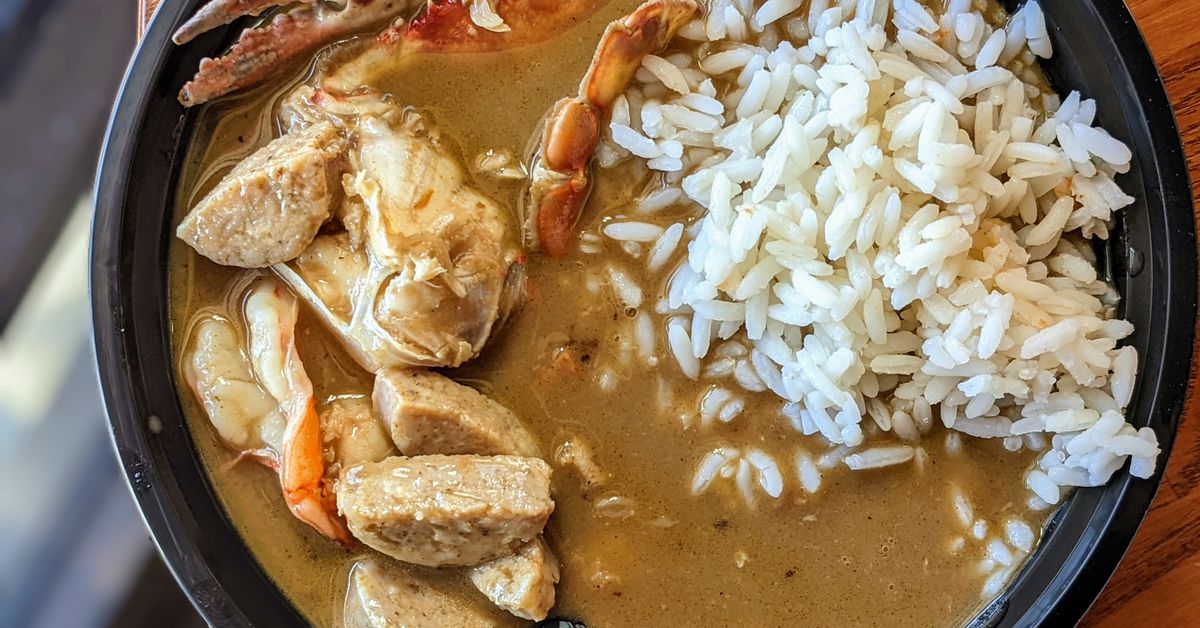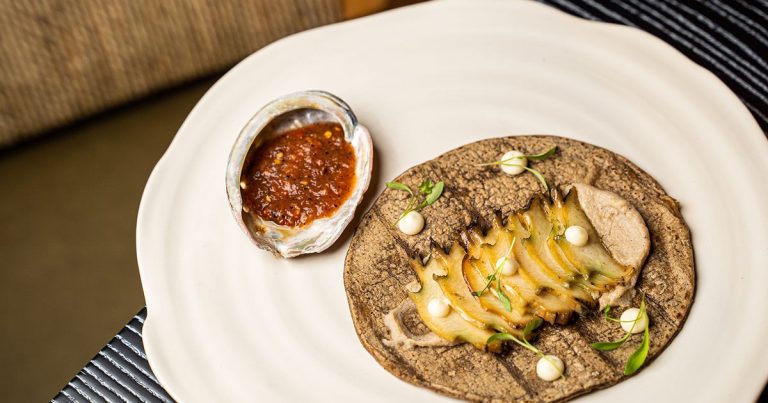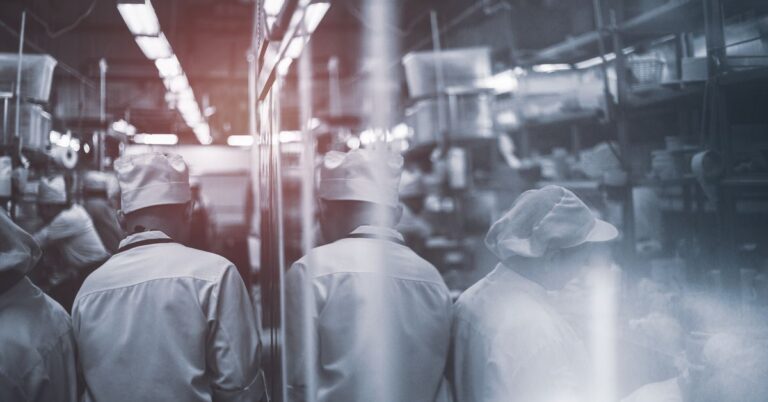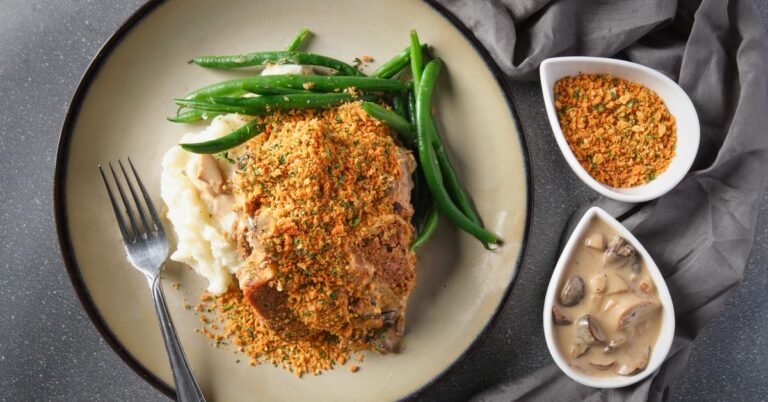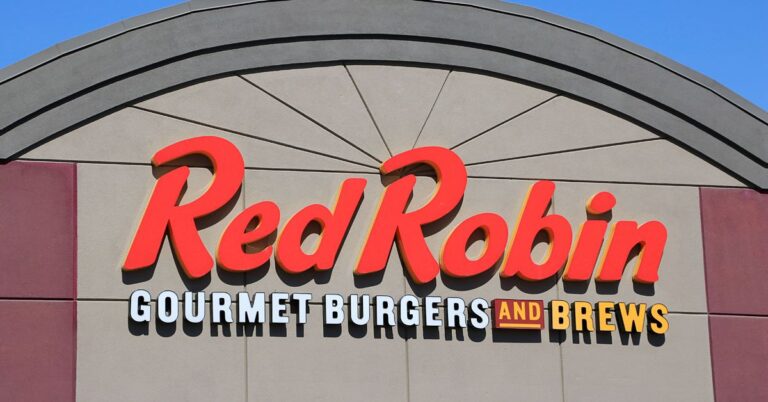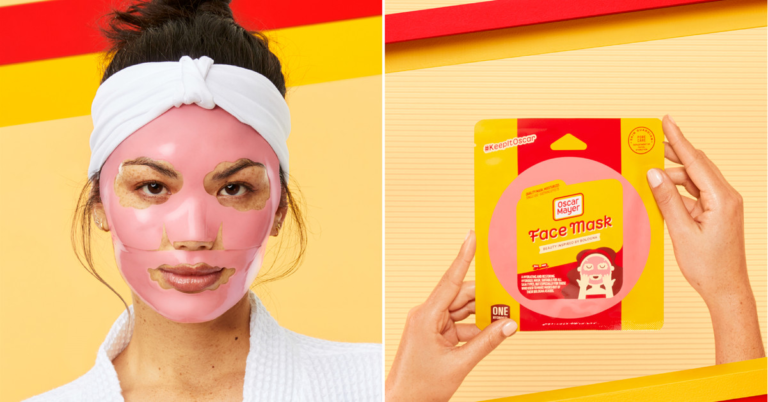How Creole Cuisine Became the Unassuming Cornerstone of LA’s Food Landscape
Walking through the ornate wooden doors of Harold & Belle’s, the clamor of traffic on Jefferson Boulevard transforms into the lively hum of the LA restaurant’s Sunday lunch rush. Chaka Khan croons over the speakers in concert with the shuffle of pots and pans echoing from the kitchen just past the bar. Waiting in the foyer, a young woman with two of her friends comments on how the nutty scent of a roux waiting to be stirred into filé gumbo reminds her of home during the holidays. A man gazing at the smooth cream walls displaying captured memories and newspaper clippings asks his wife if one of the women in a photo is her former bridge club member.
One by one, a young hostess seats each party at their table in the grand dining room. Upon being seated, a basket of crispy French bread appears. A hungry child dining with his family hastily unwraps the dark cloth napkin on top to reveal a buttery visage glistening under the light fixtures reminiscent of the street lamps found in the French Quarter. A couple of tables over, a woman on vacation from Italy scoops up the last of the popular crawfish etouffee, melding the luscious sauce into the nooks of her remaining French bread. At the tail end of the meal, owners Ryan and Jessica Legaux are likely to meander over and ask about the food. This is only after they’ve spent the last five minutes checking in with a family celebrating a birthday at the restaurant for the 10th year in a row. With a smile, they entice diners with a final course option of bread pudding, peach cobbler, or beignets. Those familiar with the culture know this brand of Southern hospitality over decadent food is the Creole way of life.
The image of streetcars, meat markets selling Creole sausage, and bakeries churning out fresh king cakes might conjure images of the French Quarter in New Orleans. However, this scene was once the norm for South Los Angeles. Back in the 1950s and ‘60s, people would step off the J line streetcar and be in the center of what was known as Little New Orleans, an area along Jefferson Boulevard between Arlington and 10th Avenue. Men socializing on porches over hogs head cheese discuss the latest events in New Orleans. Mothers scold their impatient children in Kouri-Vini while waiting in line for catfish at Girard’s Louisiana Fish Market. The aroma of perfectly toasted French bread wafts out of Big Loaf Bakery and tantalizes pedestrians.
:no_upscale()/cdn.vox-cdn.com/uploads/chorus_asset/file/23280315/AG_1110_LATLb.jpg)
Beyond the Mardi Gras decorations and play on French words, a style of hospitality emerges as the lagniappe, or something extra, at Creole restaurants. The feeling of being a part of a celebratory homecoming pushes people to look past the clichés and return for more care and conversation. As Norwood Clark Jr., founder of Darrow’s New Orleans Grill, emphasizes, “We don’t do customers. We do family.” Creole cooking takes time but the simmering of etouffee passes quickly when drinking a hurricane with friends old and new. An elder might ask seemingly invasive questions, but they are determining where someone is in their family tree or how they can be added to it. The bold, yet inviting approach to Creole food and hospitality marries well with Los Angeles’ laid-back and adventurous dining scene: Tourists and locals alike regularly dine at The Gumbo Pot in the Original Farmers Market; foodies spurred on by social media capture themselves covered in powdered sugar from treats at Christina Milian’s Beignet Box in Studio City.
Creole cuisine is the unassuming cornerstone of LA’s food landscape. The mid-to-late 20th century saw the migration of Black people from Louisiana and surrounding states to the Los Angeles area; with this population came a deep-rooted history of markets rife with delicacies like pepper jelly; fresh, perfectly ripened fruit sold by food vendors; and shrimp creole served up by restaurateurs with a smile. The appreciation for Creole culture has allowed seafood boil chains, bayou-themed bars, and “You buy, we fry” fish markets to flourish across the city. Over the last two decades, Black-owned Los Angeles restaurants and social spaces have struggled to survive amid the development of stadiums, trendy restaurants, and rising home prices. For the remaining Creole ethnic community within the larger Black Angeleno population, the closure of cultural institutions like Elks Hall, demolished in 1983, is a blow that’s left them pondering how their legacy in Los Angeles will persist.
:no_upscale()/cdn.vox-cdn.com/uploads/chorus_asset/file/23280372/IMG_2320.JPG)
:no_upscale()/cdn.vox-cdn.com/uploads/chorus_asset/file/23280375/IMG_2290.JPG)
:no_upscale()/cdn.vox-cdn.com/uploads/chorus_asset/file/23280386/IMG_2314.JPG)
Between 1940 and 1970, roughly 5 million Black Americans from the South migrated North in a period known as the Second Great Migration. Many came from states bordering the Gulf Coast, such as Texas, Louisiana, and Mississippi. Black families from Louisiana escaping Jim Crow racism primarily settled in California and Illinois. While difficult to track on census records, many of these Black Louisianans identified as Creole. Creole generally refers to people of mixed African, Native American, and colonial French or Spanish ancestry. There is racialized variation within the community, ranging from white Creoles to Black Creoles to Creoles of color. The arrival of Creoles added to the medley of ethnicities within the existent Black community, many of whom came during the 19th-century Gold Rush or were Afro-Mexicans who arrived after Mexico’s abolition of slavery in 1829.
During the Great Migration, Louisiana was the second-largest source of Black migrants in Los Angeles, just behind Texas. Approximately 15,000 Creole people traded the Gulf Coast for the West Coast, settling in Los Angeles and creating the largest Creole community in the United States outside of Louisiana. News of friends and family prospering in California inspired others to follow suit. Job opportunities primarily came from the automobile, rubber, and steel industries, which saw a post-war defense production boom spearheaded by the U.S. government establishing manufacturing plants primarily along the California coast.
According to researcher Faustina DuCros, who has a doctorate in sociology from UCLA, Creoles settled around Catholic parishes in neighborhoods like Jefferson Park, Leimert Park, and West Adams to be closer to other Creoles who migrated heavily in the late ’40s and early ’50s. With a congregation composed of majority Creoles, migrants knew the churches were where Creole culture thrived in new lands. Churches like Holy Name of Jesus and Transfiguration Catholic Church continued traditions such as St. Joseph’s feast day and Fish Fridays during Lent. La las, or zydeco dances, were also held every week at various churches. “You would have lunches where you were making this food for the community and selling it to raise money for the church. Between the restaurant businesses and the social events at churches, you still had that preservation of the food culture from Louisiana,” states DuCros.
:no_upscale()/cdn.vox-cdn.com/uploads/chorus_asset/file/23280480/IMG_2286.JPG)
Outside of the holy halls, Creoles also socialized through activities like social clubs and crawfishing in the Los Angeles River. Local hangouts like Harold & Belle’s were another refuge. Established in 1969, Harold & Belle’s opened as a small bar where patrons could shoot pool and play cards — plus gamble occasionally. Founders Harold Legaux Sr. and wife Mary Belle served a limited menu of classics like gumbo and po’ boys to friends and community members. While operating a tiny kitchen proved difficult, capturing the flavors of New Orleans was easier with markets like Louisiana Seafood Market and Pete’s Hot Sausage — a business still in operation — nearby. Much like the Latino markets across the city today, there were several Creole markets selling staples like seven steaks (a variety of chuck roast), Blue Plate mayonnaise, and Camellia red beans. Miracle Market in Compton is one of the remaining markets still selling these items.
Between Harold & Belle’s and Hungry Harold’s, a burger stand run by son Harold Leagaux Jr., the Legaux family was successful in the hospitality industry. However, more heated exchanges in the bar foreshadowed a changing environment. Civil rights movements of the late ‘60s and early ‘70s echoed the Black community’s remaining frustrations from the Watts Riots. The people were demanding change. For many, the bars and social halls of South LA served as a sanctuary from the harsh realities in the streets, but even those safe spaces could be jeopardized. One day at Harold & Belle’s, Harold Sr. was breaking up a fight over a game of pool and sustained head injuries that eventually led to his death five days later. Devastated by the passing of their fun-loving patriarch, the Legaux family abandoned the juke joint atmosphere and embraced a family-friendly restaurant in 1979, which was helmed by second-generation owners Harold Jr. and his wife Denise. With input from new business partners, they added other Creole classics to the menu and kept the welcoming attitude familiar to previous patrons. “It was about changing without alienating,” third-generation co-owner Ryan Legaux said.
The effects of both the Watts Riots and the construction of the 10 freeway in 1965 fractured the South LA community. Wealthy whites fled to the suburbs in droves between 1960 and 1980 following the arrival of their African American neighbors. However, institutions upholding housing and job discrimination lingered, allowing for predatory loans, disinvestment in urban renewal, and gang violence to plague the region. This sobering reality had many Creoles leaving South LA and moving to the Inland Empire, San Fernando Valley, and even Northern California. For the Creoles that remained in South LA, the pressure to maintain the culture was stronger than ever.
:no_upscale()/cdn.vox-cdn.com/uploads/chorus_asset/file/23280418/darrow_s_cajun_candy.jpeg)
:no_upscale()/cdn.vox-cdn.com/uploads/chorus_asset/file/23280422/darrowsstand.jpeg)
:no_upscale()/cdn.vox-cdn.com/uploads/chorus_asset/file/23280443/mardigras.jpeg)
:no_upscale()/cdn.vox-cdn.com/uploads/chorus_asset/file/23280461/PXL_20220225_214549635.PORTRAIT.jpg)
A chance at revival came with the Cajun food craze of the early 1980s. The trend lauded the spices and techniques associated with South Louisiana cuisine. In the late ’70s, an Acadian ethnic revitalization movement educated the public about the language, food, and history of the Cajun people living in Acadiana, a region in Louisiana home to much of the state’s French-speaking population. The result was a spike in interest about Cajun culinary traditions. With this movement, cultural attributes became murky and Creole people wanted to set the record straight. There were cultural similarities, but each respective community aimed to solidify cultural boundaries. Then, a chef named Paul Prudhomme flouted those deeply established divisions. Prudhomme is accredited with pioneering Cajun-Creole fusion food. Using the recipes of his Cajun upbringing and skills acquired in Creole kitchens, Prudhomme brought dishes like blackened redfish and jambalaya to the nation’s table. Today, diners can still find blackened proteins on menus.
:no_upscale()/cdn.vox-cdn.com/uploads/chorus_asset/file/23280466/darrowsmenu.jpeg)
With the sudden interest in Creole and Cajun food, many Creoles seized the opportunity to share their family recipes with the world. One of those people was Clark Jr., a native of New Orleans who came to California in 1978. A decade later, he launched Uncle Darrow’s Cajun Pecan Candy, which specialized in making praline candies and other regionally specific treats, with his family in 1988. The praline candies were a particular hit and led to business deals with Nordstrom, Neiman Marcus, and Irving “Magic” Johnson — a partnership that resulted in the confections being sold at over 30 Starbucks locations. After a leasing dispute squashed the possibility of opening a storefront in 1994, the family took time to restructure and eventually opened its Marina del Rey restaurant in 1999.
Support from Clark’s prior customers and word of mouth resulted in increased business for the restaurant. Everyone from politicians to celebrities like Halle Berry and Denzel Washington visited Uncle Darrow’s. The success was great, but Clark and his family were focused on consistency. “You get one chance to get a good impression,” he said. This quest was particularly personal to Clark, since many of his family members worked in the renowned Commander’s Palace for more than 27 years and trained with chefs like Emeril Lagasse and Paul Prudhomme. Black people have historically been the backbone of the restaurant industry in the United States and contributors to many well-loved American dishes like barbecue and mac and cheese. However, recognition for these contributions, especially through restaurant ownership, was not always achievable in an industry that did not always afford them economic or entrepreneurial agency. In discussing the early structural barriers towards culinary autonomy, Clark said, “They had all these recipes stored, but couldn’t translate. Many couldn’t read or write.”
:no_upscale()/cdn.vox-cdn.com/uploads/chorus_asset/file/23280486/PXL_20220225_214200358.jpg)
:no_upscale()/cdn.vox-cdn.com/uploads/chorus_asset/file/23280470/PXL_20220225_214149737.jpg)
Creoles are just one community within the African diaspora that impacted American cuisine. Knowing the barriers towards acknowledgement and recognition, how does a community advance their culture’s culinary legacy? One could argue by continuing to show up in the kitchen and letting others be witnesses.
Cassandra Epuna, former owner of New Orleans Cajun & Creole Cuisine, embodied this philosophy. Her mother was a celebrated cook within her family and New Orleans community and imbued into Epuna a reverence for cooking — and cooking well — for the people. Epuna would eventually transition from home entertainer to opening her Hermosa Beach restaurant in 1996. She wanted to create a comfortable, warm atmosphere for customers that mirrored eating at home. This began with beautifying the restaurant’s facade, which prompted neighboring businesses to follow suit. It then involved being one of the first faces to greet guests, while also commanding the kitchen — an impassioned dance that put strain on Epuna.
“People wanted to see me cooking in the kitchen… so I had to be there so customers would keep coming. I missed a lot of family reunions, a lot of barbecues, and a lot of everything because I had to be at the restaurant,” she says. Ever the professional, her food and hospitality became so well-known that journalists from The Times-Picayune traveled from New Orleans to Los Angeles to review her food. “They told me they appreciated me bringing the flavor of New Orleans to California. That was mind blowing for me […] I had all my aunts back home pick up copies,” Epuna says.
:no_upscale()/cdn.vox-cdn.com/uploads/chorus_asset/file/23197191/Keivan__Cooking__1_.jpg)
While some chefs, diners, and critics have said that legitimacy comes from the owners, many chefs agree that the use of Louisiana-sourced ingredients and a homey atmosphere are paramount to the authentic Creole dining experience. “I can’t sell it if it’s not a part of my background,” Norwood Clark Jr. says. Some restaurants struggle with maintaining a sense of belonging for locals because of gentrification in their communities. Over the past decade, Harold & Belle’s has seen firsthand the rapid change of Jefferson Park. In January 2022, Jefferson Park property values increased by 18.9 percent compared to last year, with homes selling for a median price of $1 million. The influx of millennials moving in has shifted the demand from long-time community spots to newer offerings in Jefferson Park and neighboring West Adams, like coffee shops and health food stores. In many ways, the streets that divide up the neighborhood also divide the people. “The people that come to these places don’t come here,” says co-owner Jessica Legaux.
This observation is puzzling considering Creole flavor remains en vogue in the mainstream. From the Popeye’s chicken sandwich to the Cheesecake Factory’s viral Louisiana chicken Caesar salad, there is more Creole-inspired food to offer, especially from Creole people.
The racial reckoning of summer 2020 created a platform for Black-owned Creole restaurants to showcase the diversity of Black American foodways. Harold & Belle’s saw a spike in customers, but no significant boost in revenue. Darrow’s New Orleans Grill reported no difference. Like many others, they still faced the harsh ultimatum of a post-COVID restaurant industry — adapt or perish.
For Darrow’s, now located in Carson, this meant limiting operating hours to avoid burnout of a shoestring staff. Harold & Belle’s transitioned to takeout dining, though indoor dining has returned on a limited basis. They also introduced vegan menu items like okra gumbo, oyster mushroom po’ boys, and meatless red beans and rice — a choice inspired by Jessica’s vegan diet and a desire to appeal to younger diners. While a promising business evolution, this change does not come without pushback from older, longtime customers. “I’ve definitely heard about how my dad did things differently and how the food used to be presented a certain way…” her husband Ryan says. “That criticism is hard to take in every day.”
:no_upscale()/cdn.vox-cdn.com/uploads/chorus_asset/file/23197253/PXL_20220125_223532219.PORTRAIT.jpg)
:no_upscale()/cdn.vox-cdn.com/uploads/chorus_asset/file/23197150/PXL_20220125_223507088.PORTRAIT.jpg)
Now, other second- and third-generation Creoles, like Keivan Cross, are further solidifying the cuisine’s legacy. Located in Downtown Montebello food hall BLVD Market, Cross owns and operates Nola Cajun & Creole, a restaurant founded on the recipes bestowed to Keivan by his aunt Cassandra Epuna. He earned this honor working in her restaurant from high school into early adulthood and testing recipes with the family matriarch in preparation for his opening. Keivan’s path differs from others in the family since he sells to a predominantly Latino population, many of whom are tasting Creole food for the first time. “Once you start to see trends, you realize, ‘OK, I need to switch this up’ or ‘I need to try something different because either they don’t like this or they’re just not there yet,’” he says. The beauty Keivan finds is that some new customers find similarities to their own cuisine.
Today, Creole restaurant owners find themselves reconstructing an overlooked legacy in Los Angeles. Around the corner from Harold & Belle’s, Georgette Powell now runs her late father’s storefront Mel’s Fish Shack and serves both a new and familiar Jefferson Park community. Further out of South Los Angeles, restaurants like Mardi Gras Tuesday and Les Sisters’ Southern Kitchen & BBQ are mainstays for Valley residents craving Creole cuisine.
Although both the customers and their relationships to restaurants and communal happenings have changed, institutions like Harold & Belle’s remind younger Creoles that their heritage always has room at the table.
